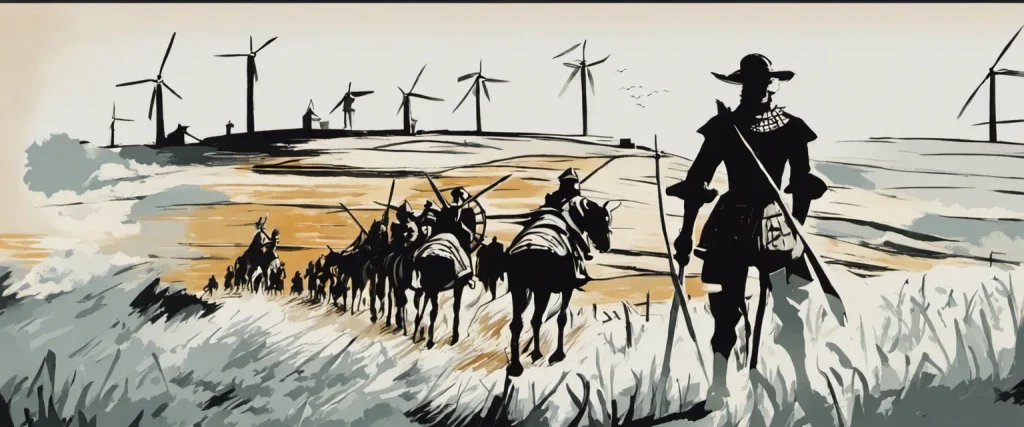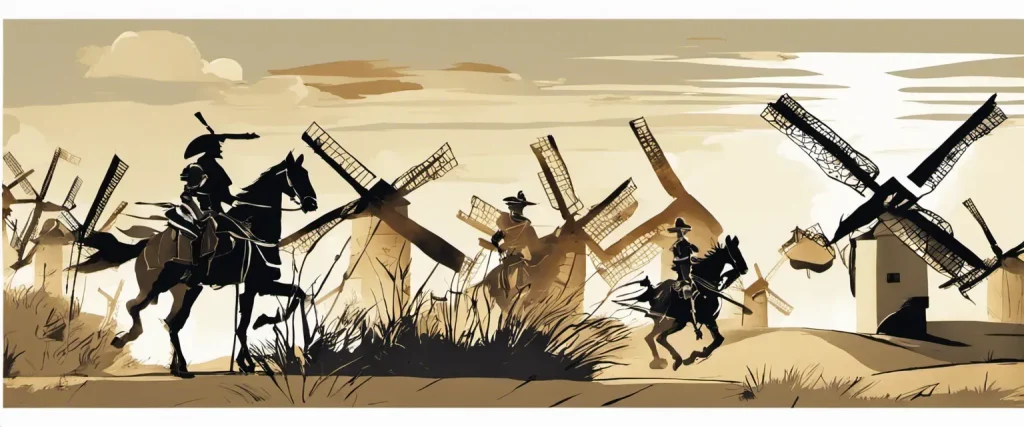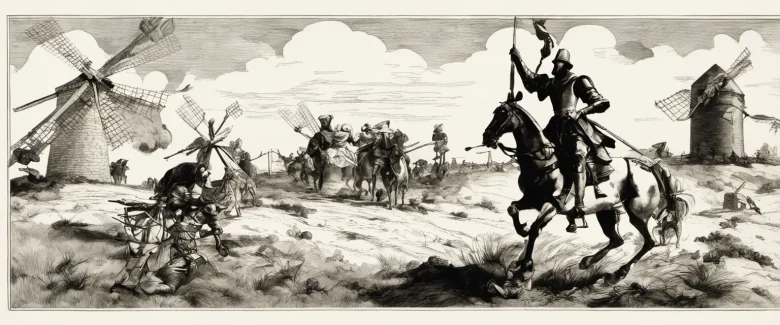Don Quixote, written by Miguel de Cervantes Saavedra, is a timeless masterpiece that tells the tale of a delusional knight and his loyal squire. Set in 16th-century Spain, the novel follows the adventures of the eccentric nobleman, Alonso Quixano, who becomes convinced that he must revive the chivalric code and become a knight-errant. Determined to bring justice to the world, Quixote embarks on a series of comical and often disastrous quests alongside his devoted sidekick, Sancho Panza. Considered one of the greatest works of fiction ever written, this novel masterfully combines humor, satire, and deep human insight. Miguel de Cervantes Saavedra, the author and a prominent figure in Spanish literature, was born in 1547 in Alcalá de Henares, Spain. Despite enduring his fair share of hardships throughout his life, including financial troubles and imprisonment, Cervantes’s immense creativity and wit made him a pioneering figure of the Spanish Golden Age. His magnum opus, Don Quixote, transformed the literary landscape and has since become a cornerstone of Western literature. Cervantes’s ability to challenge conventional notions, explore themes of identity and reality, and craft memorable characters has made him an enduring influence on subsequent generations of authors.
Chapter 1: Introduction and Madness
Chapter 1 of Miguel de Cervantes Saavedra’s renowned novel, Don Quixote, serves as an introduction to the main character and sets the stage for the madness that unfolds throughout the narrative. The chapter begins with the author’s intentions to recount the stories and adventures of a seemingly delusional knight.
The protagonist, Alonso Quixano, is introduced as an aging man who reads so many chivalry books that he becomes obsessed with the ideals of knighthood. He loses touch with reality and renames himself Don Quixote, adopting the persona of a knight-errant. Don Quixote is described as tall in stature but gaunt and sallow, indicative of his deep immersion in his fictional world.
Consumed by his obsession, Don Quixote believes that he is destined to revive chivalry and defend the helpless. He decides to embark on his own knightly quest, donning a rusty suit of armor that had been passed down through his family. The aging knight also chooses a trusted horse whom he names Rocinante, despite the fact that it is feeble and malnourished.
Don Quixote’s first adventure takes place in a nearby town, where he perceives windmills to be giants. He charges towards them with his lance, convinced that he will defeat these supposed enemies. However, the reality is that the windmills are simply inanimate objects, and Quixote is quickly thrown to the ground, suffering severe injuries.
Despite his humiliation, Don Quixote refuses to see reason and insists that he has been enchantingly defeated by a wicked sorcerer who transformed the giants into windmills to deny him his rightful victory. This episode encapsulates Don Quixote’s madness and sets the tone for the rest of the novel, as he encounters numerous similar misadventures, all spurred by his delusional perception of reality.
In this introductory chapter, Cervantes skillfully establishes the complex character of Don Quixote, his detachment from reality, and his unwavering belief in the world of chivalry and knightly ideals.
Chapter 2: Don Quixote’s First Adventure
Chapter 2 of Don Quixote, titled “Don Quixote’s First Adventure,” begins with the introduction of Alonso Quixano, a hidalgo (a member of the Spanish nobility of lower rank) who is fond of reading books about chivalry and knights. Obsessed with these stories, he decides to change his name to Don Quixote, renounce his comfortable life, and become a knight-errant to revive chivalry in the world.
Don Quixote hastily prepares for his first adventure and finds an old horse named Rocinante to be his loyal steed. He convinces himself that he must find a fair lady to serve as his inspiration like the knights in the books. Determined to set off, Don Quixote arms himself with a rusty old sword and a makeshift helmet, and he begins his journey in the early morning.
Along the way, Quixote passes by some windmills, which he mistakes as giants threatening the land. Seeing this as an opportunity to showcase his bravery, he charges towards them and attempts to attack. However, he gets entangled with one of the windmill’s sails, is thrown to the ground, and badly injured.
Sancho Panza, a simple and practical peasant, witnesses Don Quixote’s misadventure. He tries to explain that they were only windmills, but Quixote dismisses him, believing that an enchanter transformed the giants into windmills to trick him. Quixote’s injuries require medical attention, forcing him to return home for recovery.
This chapter highlights Don Quixote’s transformation from a simple hidalgo into Don Quixote, the knight-errant, as well as his first clumsy attempt at chivalrous adventure. It also introduces Sancho Panza, who becomes Don Quixote’s loyal squire and often serves as a voice of reason, albeit mostly ignored by Quixote himself.
Chapter 3: Sancho Panza Becomes Squire
Chapter 3 of Don Quixote by Miguel de Cervantes Saavedra introduces Sancho Panza, a simple and practical peasant who becomes Don Quixote’s loyal squire. Sancho Panza is initially skeptical of the knight’s madness but is lured by Dulcinea’s promised rewards.
The chapter begins with Don Quixote and Sancho Panza setting out on their adventures together. Sancho is riding a donkey, while Don Quixote, wrapped in a shabby blanket, imagines himself riding a magnificent steed. The stark contrast between their appearances symbolizes the clash between idealism and realism.
Don Quixote, still immersed in his delusions, envisions windmills as giants. Ignoring Sancho’s warnings, he charges at them with his lance, ending up being thrown to the ground by one of the blades. Sancho, although concerned for his master’s well-being, can’t help but find humor in the situation.
The Knight of the White Moon, a stranger who had been observing their encounter, appears to challenge Don Quixote in a mock joust. Don Quixote accepts and eventually loses the duel, humiliated and forced to surrender. Sancho watches in awe as his master, faith unwavering, seeks spiritual guidance and obeys his knightly code.
Seeing Don Quixote defeated, the Knight of the White Moon reveals himself as the nobleman Sampson Carrasco, a friend of Don Quixote’s from town. Carrasco chastises Don Quixote for his folly and urges him to return home. However, Don Quixote remains steadfast in his quest for chivalry and adventure.
Chapter 3 showcases Sancho Panza’s introduction to the absurd and delusional world of Don Quixote. As the difference between reality and fantasy blurs, Sancho’s loyalty to his master grows stronger, and he begins to embrace the ideals of chivalry, setting the stage for their further adventures to come.

Chapter 4: The Inn and the Imaginary Knights
In Chapter 4 of Miguel de Cervantes Saavedra’s “Don Quixote,” the delusional knight-errant, Don Quixote, arrives at an inn, believing it to be a castle. Accompanied by his loyal squire, Sancho Panza, they are warmly welcomed by the innkeeper, who plays along with Don Quixote’s delusions to amuse himself.
Don Quixote requests the innkeeper to dub him as a knight, and the innkeeper reluctantly agrees, hoping to humor the madman. Don Quixote then names the inn the “Castle of the Knights,” and the innkeeper refers to him as “The Knight of the Sorrowful Countenance,” which Don Quixote takes as a sign of his fame.
Inside the inn, Don Quixote encounters two guests, who are muleteers dressed in a similar fashion to knights, carrying shields and wearing helmets made from pasteboard. Don Quixote mistakes them for real knights and attempts to engage in a conversation about their quests and adventures. However, the muleteers, who are actually commoners, humor him while making fun of his delusions.
Later, Don Quixote witnesses the muleteers breaking some wine barrels in the courtyard of the inn, believing they are giants threatening innocent people. Driven by his chivalric ideals, Don Quixote valiantly charges at the muleteers, attempting to defeat them and fulfill his duty as a knight. In the chaos that follows, Don Quixote is beaten by the muleteers and left bruised and battered on the ground.
Despite the humiliation, Don Quixote remains firm in his convictions, attributing his defeat to enchanters who turned the giants into muleteers. Sancho Panza, on the other hand, witnesses the events with amusement and skepticism but chooses to remain loyal to his master.
Overall, this chapter highlights Don Quixote’s unwavering commitment to his fantasies, the innkeeper’s amusement and exploitation of his delusions, and the contrast between Don Quixote’s idealized vision of chivalry and the harsh reality of the inn.
Chapter 5: Dulcinea Del Toboso
In Chapter 5 of Don Quixote by Miguel de Cervantes Saavedra, the protagonist, Don Quixote, becomes increasingly obsessed with Dulcinea del Toboso, a woman he has never met but believes to be the epitome of beauty and purity. Don Quixote’s squire and voice of reason, Sancho Panza, tries to dissuade him from this delusion, asserting that Dulcinea is a simple peasant girl.
Ignoring Sancho’s protests, Don Quixote remains resolute in his conviction and vows to bring honor to Dulcinea’s name by undertaking various chivalrous quests. He further declares that he must be dubbed a knight by a lord so that he can rightfully defend Dulcinea’s honor.
Don Quixote and Sancho eventually encounter a group of merchants on the road. Convinced that they are knights, Don Quixote confronts them, demanding that they confess Dulcinea’s beauty. However, the merchants, unfamiliar with Dulcinea, mock and disrespect Don Quixote, insulting him and implying that Dulcinea is far from the virtuous lady he envisions. This riles Don Quixote, who courageously battles with the merchants until he is ultimately defeated.
In this chapter, Cervantes explores the theme of illusion versus reality. Don Quixote’s blind devotion to Dulcinea reveals his detachment from the real world and his inclination to believe his own fantasies. Sancho Panza, on the other hand, remains grounded in reality, as he perceives Dulcinea as an ordinary woman. The encounter with the merchants serves as a reminder of the ridicule that Don Quixote’s delusions can bring upon him.
Chapter 5 also highlights the developing dynamic between Don Quixote and Sancho Panza, with Sancho embodying reason and skepticism, constantly attempting to bring his master back to reality.
Chapter 6: The Sheep and the Funeral Procession
Chapter 6 of Miguel De Cervantes Saavedra’s novel Don Quixote revolves around an encounter between Don Quixote, his faithful squire Sancho Panza, and a funeral procession. As the chapter begins, Don Quixote is wandering through the fields when he notices a group of mourners carrying a coffin. In his delusional state as a knight errant, Don Quixote interprets the mourners as villains mistreating a princess or a noble lady.
Driven by his chivalrous code, Don Quixote charges at the funeral procession, attacking the mourners and attempting to liberate the supposed damsel in distress. His loyal squire, Sancho Panza, tries to reason with him, explaining that the group is merely a funeral procession. However, Don Quixote dismisses Sancho’s logic, perceiving everything through the lens of his knightly fantasies.
The funeral attendees fight back, pummeling Don Quixote with clubs and leaving him badly bruised and battered. In an ironic twist, Don Quixote interprets his injuries as proof of his valiant efforts in defending the damsel’s honor.
Eventually, the mourners manage to escape, continuing their procession. Don Quixote, though beaten and bruised, takes pride in believing that he has carried out his knightly duty. Sancho, on the other hand, questions his master’s sanity and his own involvement in such absurd adventures.
Chapter 6 of Don Quixote humorously highlights Don Quixote’s delusions and the contrast between his grandiose imagination and the mundane reality of everyday life. It showcases the extent to which Don Quixote’s eccentricity and his pursuit of chivalry lead him to misinterpret the simplest of scenarios, thereby adding to the humor and charm of the novel.

Chapter 7: The Knight of the Mirrors
Chapter 7 of “Don Quixote” by Miguel de Cervantes Saavedra introduces the reader to a new character, the Knight of the Mirrors. Don Quixote, accompanied by his loyal squire Sancho Panza, continues his chivalrous adventures. In this particular chapter, Don Quixote encounters a mysterious knight disguised in a reflective armor.
The chapter begins with Don Quixote confidently riding his horse, Rocinante, through the countryside when he spots a stranger in shiny armor approaching. This stranger proves to be the Knight of the Mirrors, named Samson Carrasco, a university graduate from Don Quixote’s village who has been following the knight’s exploits closely. Fueled by a desire to test Don Quixote’s sanity, Carrasco challenges our protagonist to a duel.
Despite Don Quixote’s initial hesitations, the Knight of the Mirrors successfully provokes his ire by insulting his beloved Dulcinea. Enraged, Don Quixote accepts the challenge and they engage in a fierce combat. As the duel ensues, Don Quixote is unable to hit Carrasco, while the Mirror Knight masterfully dodges every attack and skillfully reflects the sunlight into Don Quixote’s eyes using the mirror-like surfaces of his armor.
Eventually, the exhausted and disoriented Don Quixote is forced to surrender. Carrasco graciously accepts this victory and imposes a condition on Don Quixote: that he renounce his chivalric lifestyle and return home for one year. Don Quixote, ever the honorable knight, agrees to this condition. Thus, ends the encounter with the Knight of the Mirrors, leaving Don Quixote dismayed and humiliated.
Chapter 7 serves as an important point in the novel as it introduces the theme of self-awareness in Don Quixote’s character. The Knight of the Mirrors, posing as a challenging reflection and symbol of reality, highlights the clash between idealism and realism in Don Quixote’s mind.
Chapter 8: Return to the Village
In Chapter 8 of “Don Quixote” by Miguel de Cervantes Saavedra, the protagonist and his loyal squire, Sancho Panza, return to the village where they initially set off on their adventures. As they arrive, they encounter several locals who are both amused and astonished by their transformed appearances. Don Quixote, still delusional and believing himself to be a knight errant, asserts his identity and demands the respect and recognition he thinks he deserves.
The villagers, many of whom witnessed the chaos Don Quixote previously caused, are initially skeptical of his claims. However, the protagonist’s charisma and insistence eventually convince them, leading to a mixture of laughter, concern, and fascination. The villagers ultimately conclude that Don Quixote’s madness stems from his reading of distorted chivalric romances, which have fueled his desire to become a knight.
As Don Quixote gains attention, a barber in the village brings along a close acquaintance, Sansón Carrasco, who has a reputation as a practical joker. Sansón, aware of Don Quixote’s madness, proposes disguising himself as a knight and challenging him, hoping to cure him of his delusions. This interaction embodies the ongoing theme of the clash between fantasy and reality in the novel.
The chapter ends with the villagers eagerly awaiting the outcome of the encounter between Don Quixote and Sansón. The stage is set for the next chapter, where the reader will witness the meeting between the delusional knight and the disguised practical joker, and the potential consequences it may have on Don Quixote’s psyche.
After Reading
In conclusion, Miguel de Cervantes Saavedra’s Don Quixote is a timeless masterpiece that explores the themes of idealism, honor, and the complexities of human nature. Through the misadventures of the delusional yet endearing character of Don Quixote, Cervantes skillfully satirizes the chivalric romances of his time, while also shedding light on the power of imagination and the importance of pursuing one’s dreams. With its rich and witty prose, the novel serves as a profound reflection on the nature of reality, illusion, and the quest for meaning in a rapidly changing world. Ultimately, Don Quixote is a testament to the enduring power of literature and its ability to inspire readers to challenge societal norms and embrace their own unique journeys.
1. One Hundred Years of Solitude” by Gabriel García Márquez: This masterpiece of magical realism takes you on a mesmerizing journey through the Buendía family’s history, spanning seven generations in the fictional town of Macondo. Márquez’s lyrical prose and intricate storytelling create a rich tapestry of love, family, and the never-ending cycle of life. Prepare to be captivated by the surreal and enchanting world he weaves.
2. The Red and the Black” by Stendhal: Set in 19th-century France, this novel follows the ambitious and calculating Julien Sorel as he navigates the treacherous waters of love, politics, and social climbing. Stendhal’s psychological insight and sharp social commentary make this a compelling exploration of passion, hypocrisy, and the complexities of human nature.
3. The Life of Lazarillo de Tormes” by Anonymous: A classic of Spanish literature, “The Life of Lazarillo de Tormes” is a picaresque novel that provides a window into the harsh realities of 16th-century Spain. Through the eyes of the cunning and resourceful Lazarillo, we witness the hardships, inequality, and corruption prevalent in society. This satirical masterpiece offers a glimpse into a different time and sheds light on the plight of the marginalized.
4. “The Namesake” by Jhumpa Lahiri: This poignant and beautifully written novel explores themes of identity, belonging, and the immigrant experience. Following the journey of a Bengali couple who immigrate to the United States and their son’s struggle to forge his own path amidst cultural clashes, Lahiri delves into the complexities of heritage, assimilation, and the search for self. Her lyrical prose and empathetic storytelling make this an unforgettable read.
5. The Picture of Dorian Gray” by Oscar Wilde: In this Gothic novel, Wilde masterfully delves into the duality of human nature and the pursuit of eternal youth and beauty. As Dorian Gray’s portrait ages while he remains forever youthful, Wilde explores the consequences of vanity, hedonism, and moral corruption. This thought-provoking tale is laced with Wilde’s sharp wit and social criticism, making it a must-read for lovers of literature.



